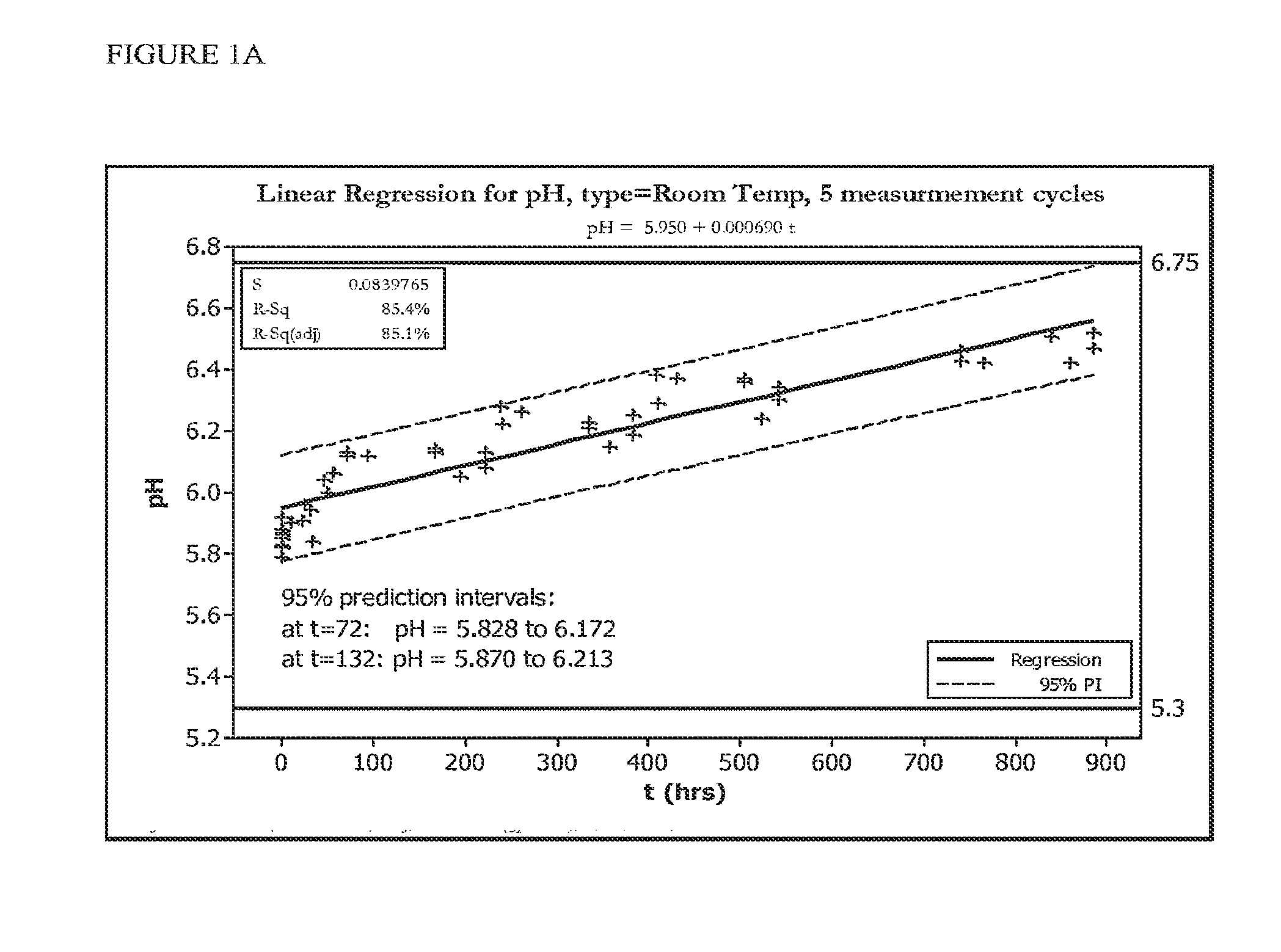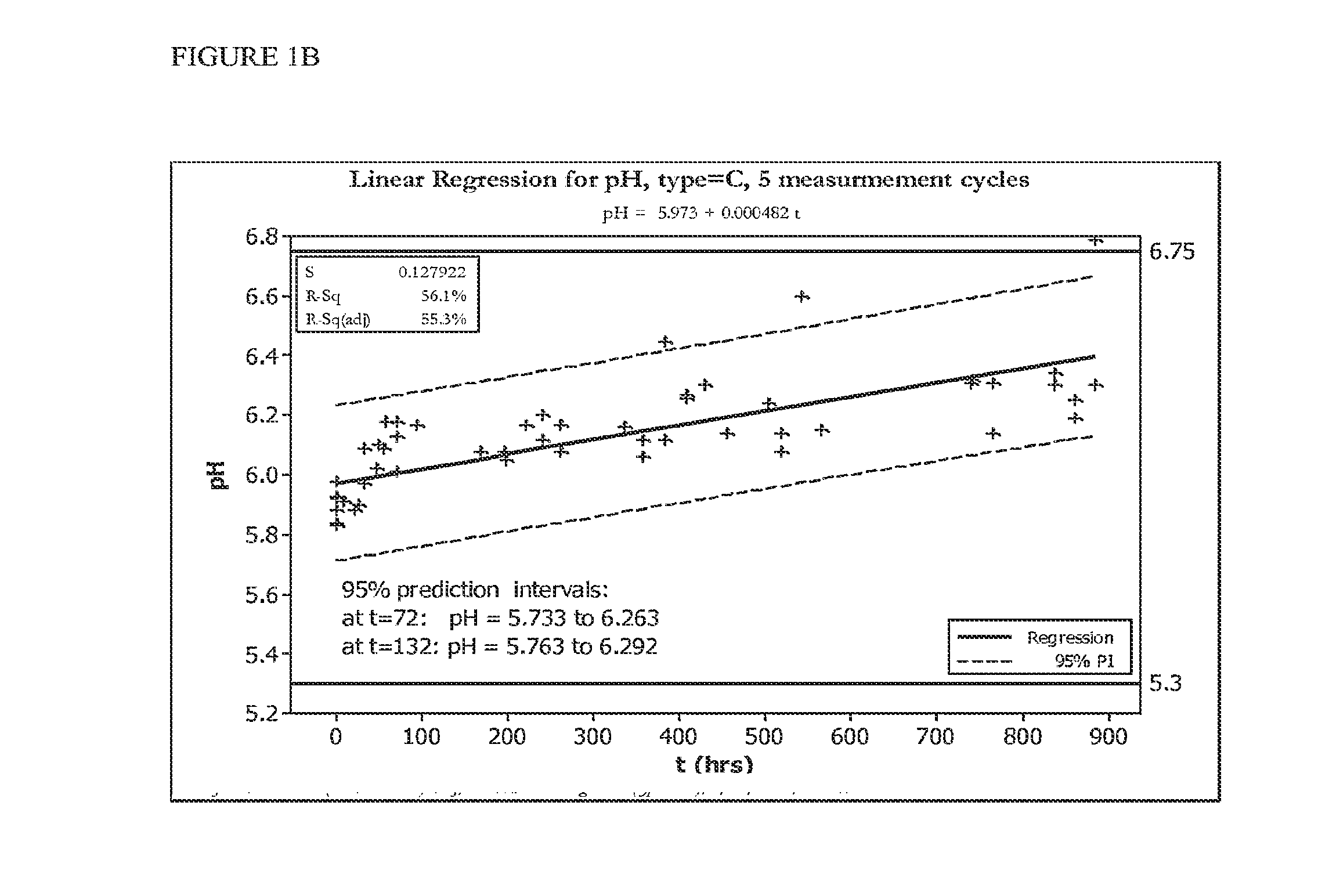Stabilized hypohalous acid solutions
a technology of stabilized solutions and hypohalous acid, which is applied in the direction of antibacterial agents, inorganic non-active ingredients, immunological disorders, etc., can solve the problems of unstable dakin's solution, unsuitable clinical use, and limited commercial use, and achieve convenient packaging for sale
- Summary
- Abstract
- Description
- Claims
- Application Information
AI Technical Summary
Benefits of technology
Problems solved by technology
Method used
Image
Examples
example 1
Stabilized Hypochlorous Acid Solution
[0055]FIGS. 1 and 2 show five cycles of AFC and pH measurements for hypochlorous acid wound treatment solutions as a function of time under two environmental conditions—COLD (C) and ROOM TEMP (R). As shown, both the pH and AFC content were not stabilized over the long term. For example, the solutions were not stabilized for more than about one week.
[0056]In an attempt to stabilize the solution, hypochlorous acid was produced by electrochemical treatment of an electrolyte comprising 4.2 g / L NaCl and 400 mg / L NaHCO3. Samples were buffered with sodium bicarbonate (NaHCO3) at pH5.6, sodium bicarbonate (NaHCO3) in combination with disodium phosphate (Na2HPO4) at 6.7, or a mix of sodium bicarbonate (NaHCO3), disodium phosphate and sodium diphosphate (9 NaH2PO4: 1 Na2HPO4) at pH5.6. Solutions were stored in the dark for 1 month in HDPE bottles prior to measuring AFC.
[0057]FIG. 3 shows the AFC drop as a function of time. The results show that solutions c...
example 2
Biocidal Activity of Stabilized HOCl Solution
[0060]Three so In comprising different concentrations of hypochlorous acid were produced. The first solution, containing 250 ppm hypochlorous acid, was produced via electrochemical treatment of an electrolyte comprising 4.2 g / L NaCl and 400 mg / L NaHCO3. The second solution, similarly produced via electrochemical treatment, contained 480 ppm hypochlorous acid, but no NaHCO3. The final solution contained 480 ppm hypochlorous acid, but in addition, incorporated 1000 mg / L NaHCO3.
[0061]To simulate a worst-case scenario, spores of C. difficile, a bacterial strain with high antibiotic resistance, were suspended in a highly concentrated organic medium, consisting of homogenized skin cells from pig, mucin, and bovine serum albumin. After suspending the microorganisms in the organic solution, they were inoculated onto plastic carriers, allowed to desiccate and exposed to each solution in duplicate for either 0, 4, 6, 8, 10 or 30 minutes. Due to the...
example 3
Extended Stability Study
[0063]FIG. 6 shows the results of an extended stability study of HOCl produced by electrochemical treatment of NaHCO3 enriched NaCl solution at targeted pH 5.4, bottled in a polyethylene terephthalate (PET) container and stored at room temperature. The molar content of NaHCO3 is equivalent to 1 mole NaHCO3 per 1 mole HOCl in this formulation. Every second month 4 new samples of HOCl stabilized solution were opened over the storage time, and then reopened one month later and tested on a weekly basis. Comparison of the pH and AFC of the first opened sample with the last opened, weekly opened during that month, confirmed the stability of HOCl stabilized with sodium bicarbonate.
PUM
 Login to View More
Login to View More Abstract
Description
Claims
Application Information
 Login to View More
Login to View More - R&D
- Intellectual Property
- Life Sciences
- Materials
- Tech Scout
- Unparalleled Data Quality
- Higher Quality Content
- 60% Fewer Hallucinations
Browse by: Latest US Patents, China's latest patents, Technical Efficacy Thesaurus, Application Domain, Technology Topic, Popular Technical Reports.
© 2025 PatSnap. All rights reserved.Legal|Privacy policy|Modern Slavery Act Transparency Statement|Sitemap|About US| Contact US: help@patsnap.com



